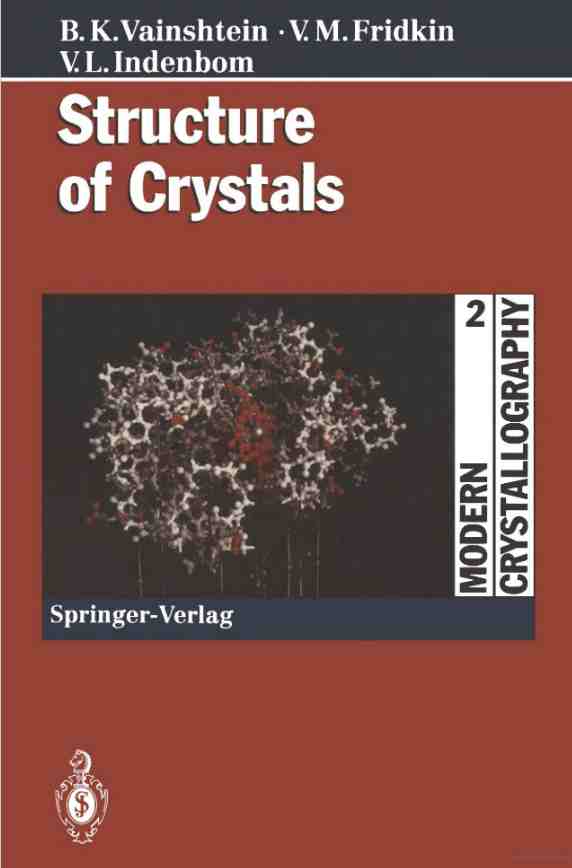


Book review
Book review
Structure of Crystals, Second, Enlarged Edition (Modern Crystallography, Volume 2)

B. K. Vainshtein, V. M. Fridkin, V. L. Indenbom
Springer-Verlag, Berlin, 1995, ISBN 3-540-56848-4, xx + 520 pp.
This is an enlarged, updated version of a book that had been originally published in 1982 as part of a Modern Crystallography series. It is intended to be a systematic view of chemical crystallography from fundamental principles of atomic structure and bonding. Chapter 1 demonstrates how atomic orbitals predicate the characteristic geometric constraints of chemical bonds and how this would lead to the symmetric arrangements of groups, clusters, or molecules in the crystalline lattice. Important for this consideration are the non-bonded potential energies, including the most important repulsive term, expressed by the radii of the interacting atoms or clusters. The principle of closest packing is developed and its consequence to problems such as solid solubility is presented. Chapter 2 discusses the characteristics of crystal structures, starting with pure elements, and building in complexity to the viruses. The problem of disorder is considered, including the nature of mesophases. In Chapter 3, the electronic structure of the crystalline lattice is re-visited to indicate how electronic properties of materials can arise from it. Chapter 4 deals with lattice dynamics and phase transitions, including the association of crystal symmetry change with crystal-crystal transitions. Defect structures are considered in Chapter 5, incorporating also the electron microscopic visualization of dislocations. Finally, Chapter 6 discusses many of the significant advances that have occurred since the publication of the first edition. Much of this review treats structural advances in the study of the fullerenes, silicates, high Tc superconductors, modular structures (where layer types can be considered as building blocks), chemical bonding (from highly-accurate crystal structures), large organic structures, alternate means of describing macromolecules (including NMR approaches) as well as the crystallographic study of very large molecules, and Langmuir-Blodgett films.
There is much to be admired in this attempt to find a unified approach to the description of crystal structures and one cannot imagine many people more capable of this undertaking than Prof. Vainshtein. Personally, I found much of this book to be useful, particularly the first two chapters and some of the topics in the sixth. Many of the arguments and presentations are clearly made in a tradition that also includes the earlier work of A. I. Kitaigorodskii.
Inevitably, however, such an undertaking is quite ambitious and suffers for not being at least twice the length of the current volume, which only gives an initial 'taste' for many topics that might deserve a fuller exposition. It would have been helpful too if the newer material in the last chapter could have been integrated into the previous chapters, where the initial discussion of the respective topics was given, if only to foster the unity of the text. (In fact there is very little in the earlier chapters that is amended for the newer edition.) There are a number of significant developments that have been omitted - especially the striking advances in high resolution structural electron crystallography (a field that was pioneered by Prof. Vainshtein) for the characterization of integral membrane proteins - including the fitting of polypeptide chain models to the three-dimensional potential maps. It is also too bad that there are not many references beyond 1991 in Chapter 6, given the explosive development of certain research areas mentioned there.
Despite these minor criticisms the presence of this series on a crystallographer's or materials scientist's bookshelf is highly recommended. Its strength lies in its portrayal of various levels of organization in crystalline systems and how even disorder must be related to the underlying constraints of a crystalline lattice. X-ray crystallographers will find expansions of the structures of pure materials into the larger dimensional realms more familiar to the electron microscope using materials scientist. Likewise,the materials scientists can discover the fundamental crystallographic underpinnings for the defect-containing preparations studied by them. Such a treatment of hierarchical order may do much to foster needed dialogs amongst various disciplines and promote the teaching of crystallography as an interdisciplinary science.
Douglas L. DorsetHauptman-Woodward Inst.
Buffalo, NY, USA


